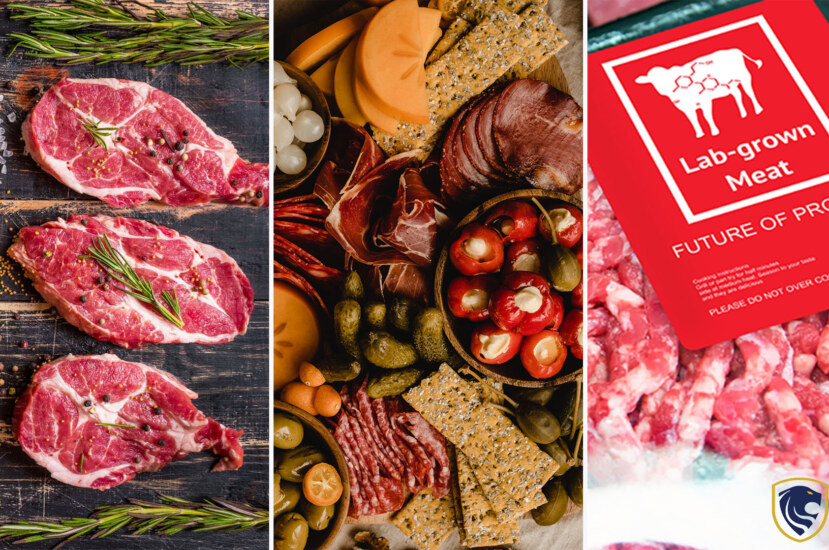Lab-grown meat, also known as cultivated or cultured meat, is actual meat that is generated from the animal cells themselves. Although it may seem like the stuff of the future, supermarket shelves will soon be stocked with meat that has been grown in a laboratory. In reality, a team from the University of Maastricht unveiled the first hamburger made from ovine stem cells in 2013. That marked the first time lab-grown meat was showcased to the world. This unique burger originally cost more than $300,000 to make. However, researchers discovered that they were able to lower the cost to $11.36 two years later.
How is meat cultured?
An adult animal’s satellite muscle cells are isolated in the initial stage. To put it another way, these satellite cells have a physiological role in helping muscles regenerate. They are stem cells with the capacity to multiply and specialize into muscle cells in response to particular hormones.
In order to promote fast proliferation, the satellite cells are stimulated with growth stimulants and cultivated in bioreactors. Those are sterile containers holding nourishing liquids. Afterward, they are physically integrated into muscle tissue to create an edible artificial steak after being turned into muscle cells.

How is meat cultured?
The development of cultured meat will greatly minimize the environmental effect of meat production as well as the possibility of infectious illnesses being passed from animals to people, according to the website of Mosa Meat, the Netherlands firm founded by Mark Post. Also, the business claims that the flavor of cultured meat is comparable to that of regular beef.
Also, according to experts, cultured meat holds the secret to feeding a planet whose population is expected to surpass 9.5 billion by 2050 while also respecting animals and protecting the environment.
Will It Be In the global diet in 2050?
Conventional meat production contributes significantly to world water and energy consumption (8%) and emissions of greenhouse gases, according to the United Nations Food and Agriculture Organization. Moreover, the FAO predicts that meat consumption will double by 2050 despite the fact that meat production has already reached its peak. What is the answer to this issue?
Cows are “extremely inefficient,” with a 15% “bioconversion rate.” In other words, 100 grams of vegetable protein are required to generate 15 grams of meat. So, increasing the efficiency rate is the only method to produce meat in a sustainable manner.

Will It Be In the global diet in 2050?
Several approaches have been attempted previously, such as creating meat from proteins sourced from plants or insects. Yet, because of cultural prejudices and the difficulties of replicating the flavor and texture of traditional meat, these alternatives don’t always please customers. These issues might be avoided with in vitro meat.
Is Cultured Meat Vegan?
Lab-produced meats are not exactly vegan. A product must be tested on animals and cannot include any animal products or derivatives in order to be considered appropriate for a vegan diet. And as we’ve explained, animal cells extracted from superior farm animals are cultivated in laboratories to produce lab-made meat.

Is Cultured Meat Vegan?
When Will Cultured- Meat Become Available?
According to the US Food and Drug Administration, as of September 2022, there are no food items created from animal cells in culture that can be purchased on the US market. But that doesn’t mean there won’t be any soon. Manufacturers are typically focused on scaling up their processes to reliably produce volumes large enough to be competitively priced.
Manufacturers must also ensure that their farm-raised beef satisfies a demanding set of standards in order to have their product displayed in supermarkets. Moreover, they are actively collaborating with the US Department of Agriculture’s Food Safety. And they are Inspecting as these items approach the American market. The FDA and USDA strict FSIS’s standards for safety and proper labeling apply to all food products. It includes those produced into human food items using cultivated animal cells.
The FDA acknowledged that it had already begun discussions with a number of businesses for a variety of food items manufactured from cultured cells. That includes those made from cultured marine cells.

When Will Cultured- Meat Become Available?
Why Should We Produce Meat In Labs?
reduced contaminants: The E. coli bacteria, which is found in animal feces. Also, other pollutants that may be present in a meat processing factory, according to advocates of cultured meat, are considerably less likely to be present in it.
fewer antibacterial: Antibiotics are frequently administered to livestock that is grown traditionally to help maintain their health. Antibiotic resistance is a condition when the medications no longer effectively treat infections.
less damage to the environment: The more forested area is being converted to ranches and farming fields as the demand for meat increases worldwide. In contrast, m eat that has been cultured requires substantially less land, water, and pollutants.

When Will Cultured- Meat Become Available?
Also, conventional beef farming produces a lot of so-called greenhouse gases including methane, carbon dioxide, and nitrous oxide, which contribute to global warming. Meat produced in laboratories may greatly minimize these pollutants.
less cruel to animals:. While cultured meat needs a little amount of tissue, no animals need to be killed in the process. Animals that are still alive can provide the cells. While some of the nutrient baths used to develop the cells do include animal blood, other ones do not.
less resources are used:
In our globe, 70% of the agricultural land is used for livestock production. Yet, it is possible to supply the demand for meat by generating it from cells rather than by breeding more farm animals. Smaller agricultural resources are therefore utilized.
However, the amount of land needed for meat production might be reduced by a staggering 99% if we switched entirely to farmed meat.
Using lab-grown meat also conserves water resources that would otherwise be used to produce genuine meat. Animal husbandry presently uses 92% of all water.
Around 15 liters of water are required for 1 kilogram of beef . Meat produced in a greenhouse can save water use by 82% to 96%.

When Will Cultured- Meat Become Available?
More Convenient Food:
By 2050, 9.5 billion people are anticipated to be on the planet. As a result, future generations will want more food, yet our supply of land, water, and animals is finite.
It will be hard to produce enough animals to feed the growing population, according to certain research.
When compared to how meat is typically manufactured, generated meat requires a small fraction of the resources. And it doesn’t involve the killing of animals. In other words, laboratory-produced meat can feed an expanding population.
Healthier:
Meat developed in laboratories can have its amino acid and lipid composition modified. The meat can be enhanced by the makers with extra vitamins and minerals.
Scientists have the ability to regulate the fat content of meat, lower cholesterol, or even add heart-healthy fats like Omega-3.

When Will Cultured- Meat Become Available?
Negatives In Cultured Meat
Not generally accessible:
Cultured meat hamburgers, hot dogs, and other cuts aren’t offered in the American market, in contrast to plant-based meat, which is now often seen in supermarkets. To make meat and get it on grocery shelves, cultivated meat producers will need to adhere to a tight set of requirements.
Fortunately, there has been some advancement in the accessibility of cultured beef. There is a good likelihood that shops will start carrying lab-grown meat in the years to come because the FDA finished its first pre-market consultation for meat derived from animal cells in November 2022.
Not vegan


